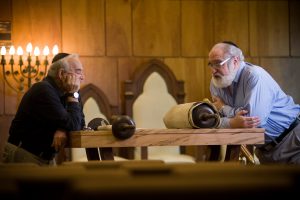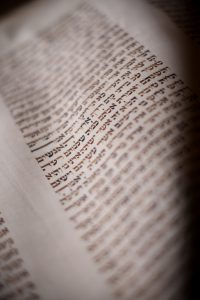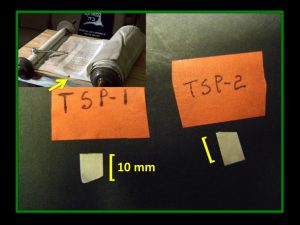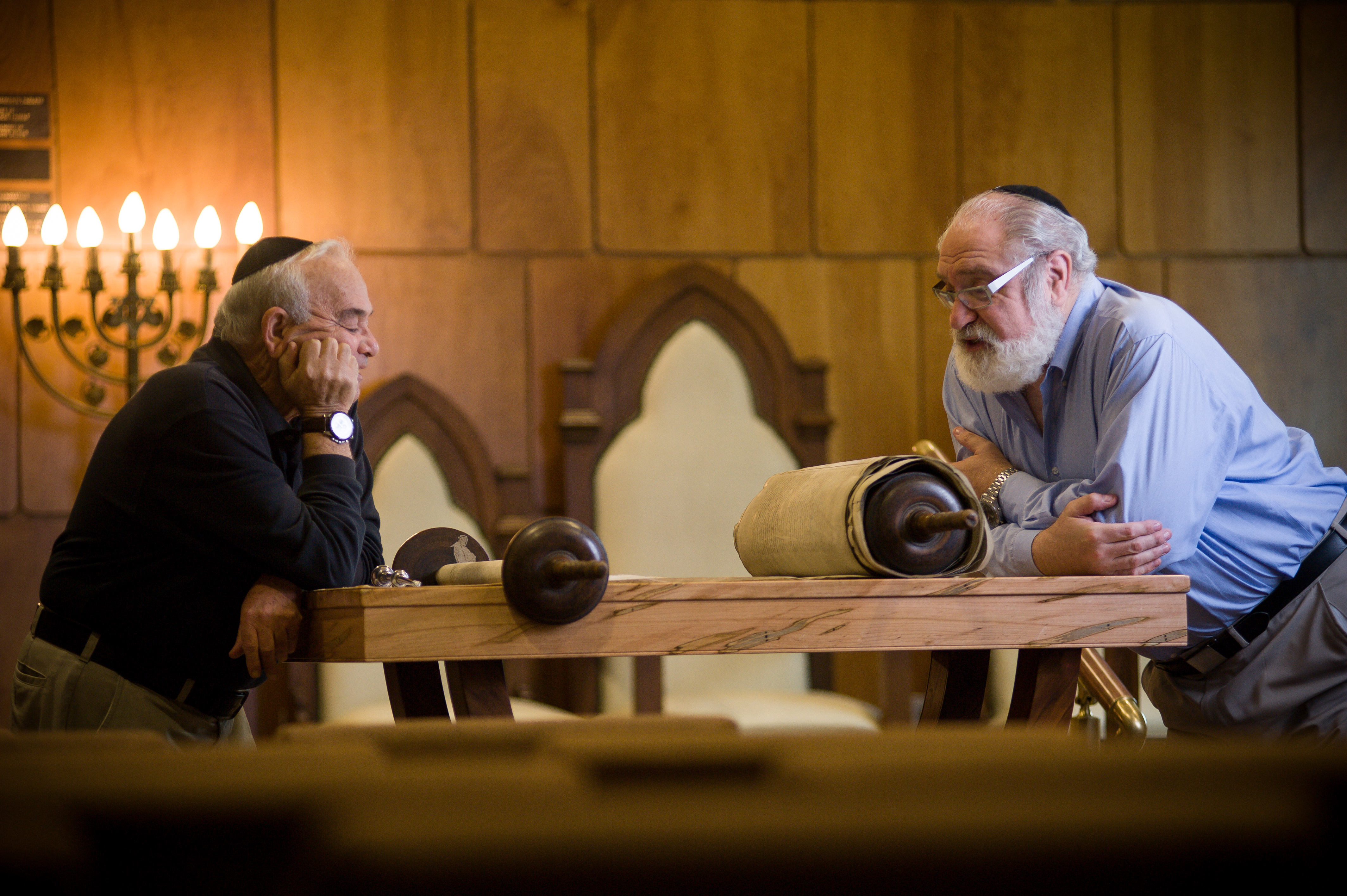By Cathy Butler
Photos by Zach Riggins
Saved from the Holocaust, a Torah is brought to Temple Emanu-El on the UA campus, where a member of the congregation helps discover its true – and astounding – age.
CZECHOSLOVAKIA

With black ink and a sharp quill, a sofer (scribe who writes a scroll) copied the Five Books of Moses onto parchment made from the skin of a kosher animal, likely a lamb or sheep. Following guidelines set forth by the medieval Spanish scholar Maimonides (1135-1204), the scribe recited each word aloud as line after line was copied. Mistakes made when writing the name of God required certain rituals and prayers before work could continue.
When the final letter was made, the parchment sheets were sewn together with animal sinew and placed around wooden rollers. The finished scroll, unsigned and undated, as was also customary, at some point went to a Jewish congregation in the regions of Moravia and Bohemia.
There it remained until the 1939 German invasion. While the Czech and Slovak Jews were deported, enslaved and murdered, the Nazis looted more than 1,500 scrolls and countless other synagogue items. Many, but not all, were tagged with the name of the congregation and area where they were seized. With their defeat, whatever plans the Nazis had for the scrolls vanished.
For the next two decades the scroll languished in storage.
LONDON

In 1963, with the help of a concerned art dealer, the looted scrolls were acquired from the Czechoslovakian government and put into the keeping of the Westminster Synagogue. The scroll, along with the others, was shipped to London.
The Memorial Scrolls Committee of the Westminster Synagogue has spent the last 50 years sorting, evaluating and restoring the Czech scrolls and placing them on permanent loan with Jewish congregations and other institutions worldwide.
Dr. Steven Jacobs, Aaron Aronov Endowed Chair of Judaic Studies in the UA department of religious studies, is a genocide and Holocaust scholar, and the child of Holocaust survivors. He helped place Westminster scrolls with congregations in Huntsville, Mobile and Birmingham. As rabbi of Temple Emanu-El, located in an area dubbed “the God Quad” for its many houses of worship, he welcomed the opportunity to bring a Sefer Torah (Torah Scroll) to Tuscaloosa.
TUSCALOOSA
The scroll reached Temple Emanu-El in 2015. “It was in excellent condition,” Jacobs said. “Some words have been re-inked, and it’s been repaired, but it was beautiful.” However, this was one of the scrolls lacking identification.
“We didn’t expect to know who made it or when. But we wished we could know more about it and the people from whom it was stolen. We wondered, ‘Where exactly was it stolen? Which congregation had it? How old was it?’” Jacobs said.
The former questions remain a mystery, but science and Paul Aharon were able to answer the latter.
Dr. Paul Aharon, Ray E. Loper Endowed Chair in the department of geological sciences at UA (now retired), is a member of Temple Emanu-El and chair of its ritual committee. At the time the scroll arrived, his research involved radiocarbon dating, a process to measure and calculate the age of organic materials based on the amount of the radioisotope Carbon-14 found there.
The scroll was animal skin. What if, he wondered, they could radiocarbon date it? Jacobs and the congregation were excited to think they could at least know their Torah’s age.
Westminster Synagogue granted permission, and Aharon secured the cooperation of the National Ocean Sciences Accelerator Mass Spectrometry (NOSAMS) facility at Woods Hole Oceanographic Institution in Massachusetts, which agreed to work pro bono.
But, because the radiocarbon dating process turns the material to graphite, thereby destroying the sample, a piece of scroll would have to be sacrificed. And, since the findings would have to be duplicated to assure accuracy, more than one sample was needed.
The fact the scroll would have to be cut twice dismayed but did not deter Jacobs or Aharon, who said, “I was reluctant to cut the scroll, and I took no more than absolutely necessary.”
Contamination would invalidate the results; the process had to be followed exactly. With pristine scissors and wearing gloves, he snipped two fingernail-sized samples. The snippets were then prepared, labeled and shipped to Massachusetts.
WOODS HOLE, MASSACHUSETTS

A newer technology, the Accelerator Mass Spectrometer (AMS) differs from the conventional beta-counting technique. It requires a much smaller sample – milligrams rather than grams – and results take hours versus days.
“I could not have done this testing even 10 years ago,” Aharon said. “The technology to use such a small piece of the scroll did not exist.”
Turned to graphite, what had once been part of the Torah sped through the mass spectrometer at high velocity, the atoms becoming ionized, the heavier Carbon-14 separating from the chemically identical Carbon-12 and Carbon-13 isotopes, allowing it to be measured.
Within weeks, Woods Hole reported that the scroll was 750 years old, making it the second-oldest complete Torah scroll known. (The oldest, dating from 1155-1255, is in the University of Bologna in Italy.)
As Jacobs and Aharon stood together inside Temple Emanu-El, reading the Torah and discussing the discovery, Jacobs said, “We had no idea when the Torah arrived that we were receiving the second-oldest complete Torah known. And if Paul hadn’t suggested radiocarbon dating, we would never have known.”
“Well, most discoveries are by serendipity,” Aharon replied. “But it is because this scroll came to a congregation on The University of Alabama campus, with members who were also scientists and religious studies scholars, that this came to pass.
“This was a dovetail of science and religion and neither impinged on the other,” Aharon said.
IN HONOR AND IN MEMORY OF THE SIX MILLION
While the scroll’s provenance may fascinate scholars, its age has no bearing on its religious significance, which rests in the words themselves, Jacobs said. Neither relic nor museum piece, it is now kept with two other Sifrei Torah (Torah scrolls) in the Aron Kodesh (Holy Ark). Brought out at certain times, particularly when the congregation commemorates the millions killed in the Shoah, or Holocaust, it is a reminder of both what was lost and what was saved.
“We feel that this scroll is our survivor and has now found a home,” Jacobs said.
